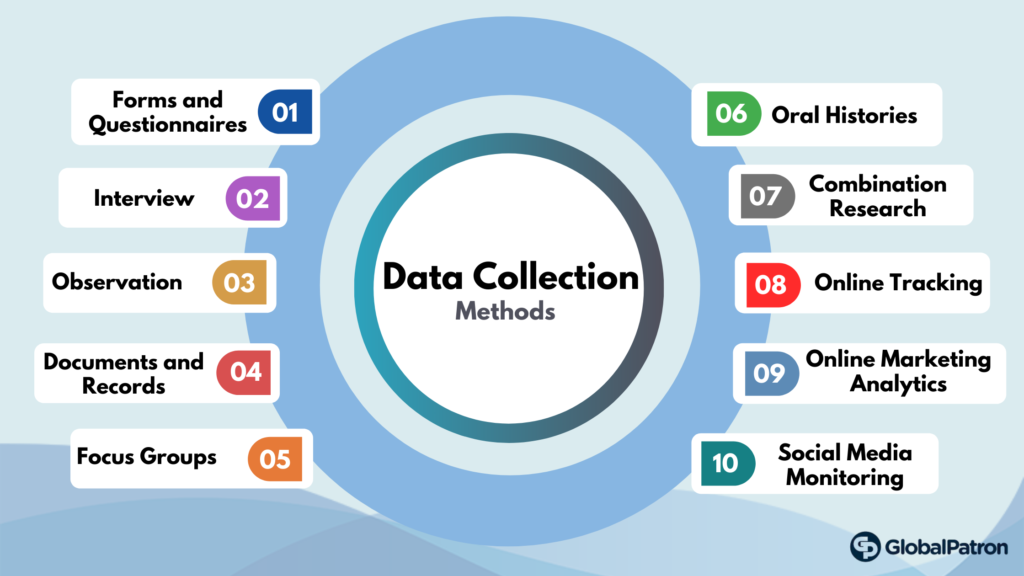Introduction
Data collection is the process of gathering data for use in business decision-making, strategic planning, research, and other purposes.
It’s a crucial part of data analytics applications and research projects: Effective data collection provides the information that’s needed to answer questions, analyze business performance or other outcomes, and predict future trends, actions, and scenarios.

During data collection, the researchers must identify the data types, the sources of data, and what methods are being used. We will soon see that there are many different data collection methods. There is heavy reliance on data collection in research, commercial, and government fields.

Need For Data Collection
The best courses of action come from informed decisions, and information and data are synonymous.
The concept of data collection isn’t a new one, as we’ll see later, but the world has changed. There is far more data available today, and it exists in forms that were unheard of a century ago. The data collection process has had to change and grow with the times, keeping pace with technology.
Whether you’re in the world of academia, trying to conduct research, or part of the commercial sector, thinking of how to promote a new product, you need data collection to help you make better choices.
Methods of Collecting Data
-
Primary.
As the name implies, this is original, first-hand data collected by the data researchers. This process is the initial information gathering step, performed before anyone carries out any further or related research. Primary data results are highly accurate provided the researcher collects the information. However, there’s a downside, as first-hand research is potentially time-consuming and expensive.
-
Secondary.
Secondary data is second-hand data collected by other parties and already having undergone statistical analysis. This data is either information that the researcher has tasked other people to collect or information the researcher has looked up. Simply put, it’s second-hand information. Although it’s easier and cheaper to obtain than primary information, secondary information raises concerns regarding accuracy and authenticity. Quantitative data makes up a majority of secondary data.

Primary Data Collection Methods
Primary data or raw data is a type of information that is obtained directly from the first-hand source through experiments, surveys or observations. The primary data collection method is further classified into two types. They are
- Quantitative Data Collection Methods
- Qualitative Data Collection Methods
Let us discuss the different methods performed to collect the data under these two data collection methods.
Quantitative Data Collection Methods
It is based on mathematical calculations using various formats like close-ended questions, correlation and regression methods, mean, median or mode measures. This method is cheaper than qualitative data collection methods and it can be applied in a short duration of time.
Qualitative Data Collection Methods
It does not involve any mathematical calculations. This method is closely associated with elements that are not quantifiable. This qualitative data collection method includes interviews, questionnaires, observations, case studies, etc. There are several methods to collect this type of data. They are
Observation Method
Observation method is used when the study relates to behavioral science. This method is planned systematically. It is subject to many controls and checks. The different types of observations are:
- Structured and unstructured observation
- Controlled and uncontrolled observation
- Participant, non-participant and disguised observation
Interview Method
The method of collecting data in terms of verbal responses. It is achieved in two ways, such as
- Personal Interview – In this method, a person known as an interviewer is required to ask questions face to face to the other person. The personal interview can be structured or unstructured, direct investigation, focused conversation, etc.
- Telephonic Interview – In this method, an interviewer obtains information by contacting people on the telephone to ask the questions or views, verbally.
Questionnaire Method
In this method, the set of questions are mailed to the respondent. They should read, reply and subsequently return the questionnaire. The questions are printed in the definite order on the form. A good survey should have the following features:
- Short and simple
- Should follow a logical sequence
- Provide adequate space for answers
- Avoid technical terms
- Should have good physical appearance such as colour, quality of the paper to attract the attention of the respondent
Schedules
This method is similar to the questionnaire method with a slight difference. The enumerations are specially appointed for the purpose of filling the schedules. It explains the aims and objects of the investigation and may remove misunderstandings, if any have come up. Enumerators should be trained to perform their job with hard work and patience.
Secondary Data Collection Methods
Secondary data is data collected by someone other than the actual user. It means that the information is already available, and someone analyses it. The secondary data includes magazines, newspapers, books, journals, etc. It may be either published data or unpublished data.
Published data are available in various resources including
- Government publications
- Public records
- Historical and statistical documents
- Business documents
- Technical and trade journals
Unpublished data includes
- Diaries
- Letters
- Unpublished biographies, etc.
Collection of Data in Statistics
There are various ways to represent data after gathering. But, the most popular method is to tabulate the data using tally marks and then represent them in a frequency distribution table. The frequency distribution table is constructed by using the tally marks. Tally marks are a form of a numerical system used for counting. The vertical lines are used for the counting. The cross line is placed over the four lines gives the total 5.
Reliability & Validity
Reliability and validity are both about how well a method measures something:
- Reliability refers to the consistency of a measure (whether the results can be reproduced under the same conditions).
- Validity refers to the accuracy of a measure (whether the results really do represent what they are supposed to measure).
Operationalization
Operationalization means turning abstract conceptual ideas into measurable observations.
For example, the concept of social anxiety isn’t directly observable, but it can be operationally defined in terms of self-rating scores, behavioral avoidance of crowded places, or physical anxiety symptoms in social situations.
Before collecting data, it’s important to consider how you will operationalize the variables that you want to measure.
Conclusion
To ensure that high quality data is recorded in a systematic way, here are some best practices:
- Record all relevant information as and when you obtain data. For example, note down whether or how lab equipment is recalibrated during an experimental study.
- Double-check manual data entry for errors.
- If you collect quantitative data, you can assess the reliability and validity to get an indication of your data quality.




